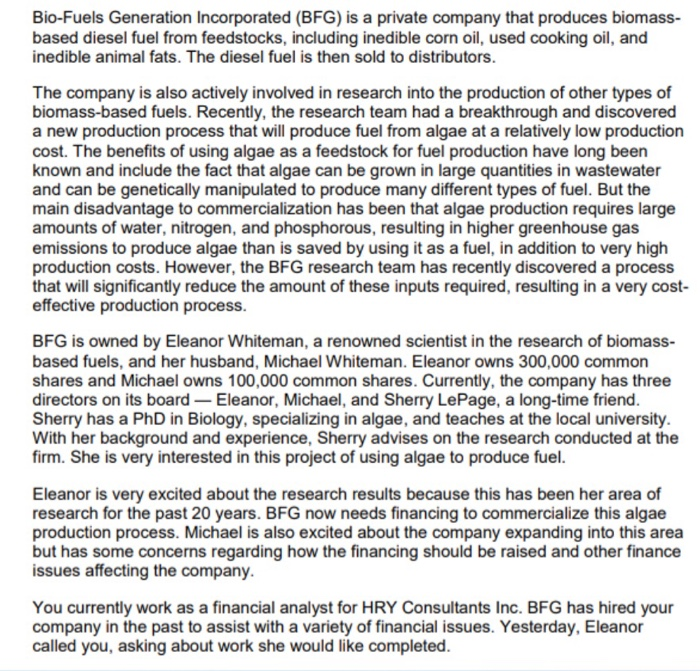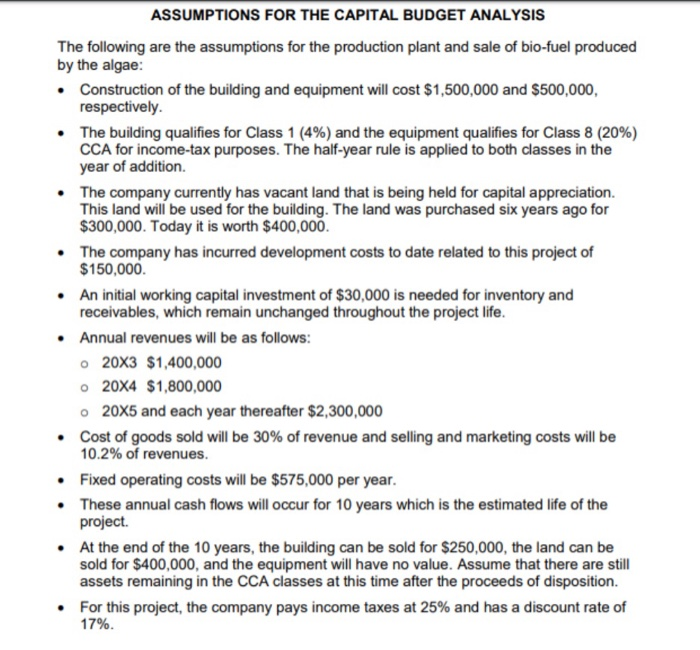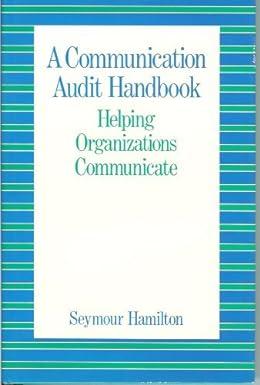Answered step by step
Verified Expert Solution
Question
1 Approved Answer
what information do you need? your comment just has a colen? Bio-Fuels Generation Incorporated (BFG) is a private company that produces biomass- based diesel fuel










what information do you need? your comment just has a colen?
Bio-Fuels Generation Incorporated (BFG) is a private company that produces biomass- based diesel fuel from feedstocks, including inedible corn oil, used cooking oil, and inedible animal fats. The diesel fuel is then sold to distributors. The company is also actively involved in research into the production of other types of biomass-based fuels. Recently, the research team had a breakthrough and discovered a new production process that will produce fuel from algae at a relatively low production cost. The benefits of using algae as a feedstock for fuel production have long been known and include the fact that algae can be grown in large quantities in wastewater and can be genetically manipulated to produce many different types of fuel. But the main disadvantage to commercialization has been that algae production requires large amounts of water, nitrogen, and phosphorous, resulting in higher greenhouse gas emissions to produce algae than is saved by using it as a fuel, in addition to very high production costs. However, the BFG research team has recently discovered a process that will significantly reduce the amount of these inputs required, resulting in a very cost- effective production process. BFG is owned by Eleanor Whiteman, a renowned scientist in the research of biomass- based fuels, and her husband, Michael Whiteman. Eleanor owns 300,000 common shares and Michael owns 100,000 common shares. Currently, the company has three directors on its board - Eleanor, Michael, and Sherry LePage, a long-time friend. Sherry has a PhD in Biology, specializing in algae, and teaches at the local university. With her background and experience, Sherry advises on the research conducted at the firm. She is very interested in this project of using algae to produce fuel. Eleanor is very excited about the research results because this has been her area of research for the past 20 years. BFG now needs financing to commercialize this algae production process. Michael is also excited about the company expanding into this area but has some concerns regarding how the financing should be raised and other finance issues affecting the company. You currently work as a financial analyst for HRY Consultants Inc. BFG has hired your company in the past to assist with a variety of financial issues. Yesterday, Eleanor called you, asking about work she would like completed. ASSUMPTIONS FOR THE CAPITAL BUDGET ANALYSIS The following are the assumptions for the production plant and sale of bio-fuel produced by the algae: Construction of the building and equipment will cost $1,500,000 and $500,000, respectively. The building qualifies for Class 1 (4%) and the equipment qualifies for Class 8 (20%) CCA for income tax purposes. The half-year rule is applied to both classes in the year of addition The company currently has vacant land that is being held for capital appreciation. This land will be used for the building. The land was purchased six years ago for $300,000. Today it is worth $400,000. The company has incurred development costs to date related to this project of $150,000. An initial working capital investment of $30,000 is needed for inventory and receivables, which remain unchanged throughout the project life. Annual revenues will be as follows: 20x3 $1,400,000 2004 $1,800,000 20x5 and each year thereafter $2,300,000 Cost of goods sold will be 30% of revenue and selling and marketing costs will be 10.2% of revenues Fixed operating costs will be $575,000 per year. These annual cash flows will occur for 10 years which is the estimated life of the project At the end of the 10 years, the building can be sold for $250,000, the land can be sold for $400,000, and the equipment will have no value. Assume that there are still assets remaining in the CCA classes at this time after the proceeds of disposition. For this project, the company pays income taxes at 25% and has a discount rate of 17%. 4. BFG's corporate income tax rate is currently 25%. 5. Based on market data, you have determined that the current risk-free rate is 3% and the expected market price of risk is 5%. You have estimated that the industry beta is 1.9. CURRENT CAPITAL STRUCTURE AND PROPOSALS The company has the following issued capital: 1. Line of credit - First Royal Bank - The line of credit has a maximum amount of $200,000 and is secured by the accounts receivable and inventory. The line of credit bears interest at prime plus 2.5%. Currently, prime is at 3.5%. 2. Long-term debt - First Royal Bank The long-term debt matures December 31, 20x9, when the full amount of the principal is due. The loan bears interest at 9%, which is payable annually. The loan is secured by the property, plant, and equipment. The long-term debt has a covenant that the long-term debt to total asset ratio cannot exceed 0.70. 3. Eleanor has approached two potential investors for investment in the algae bio-fuel project. The proposals from each party are outlined below: a. Trinity Venture Capitalists (Trinity) - When BFG started operations, Trinity provided some initial funding which has since been paid back. Trinity is now proposing to invest $2,000,000, to be used to commercialize the algae production. BFG will issue 200,000 non-voting, cumulative preferred shares at a price of $10 per share. Cumulative dividends at the rate of 6% will be paid on the preferred shares. These shares are convertible into common shares on a one-to- one basis at the option of Trinity any time after 20X5. Any dividends in arrears must be fully paid prior to redemption or conversion. BFG may redeem these shares any time after 20X9 and prior to conversion. Trinity requires that two representatives be members on the board of directors who will be involved in the day-to-day operating, strategic, and financial decisions. b. Sherry LePage, a private investor and current board member - Sherry recently inherited some cash and is looking to make an investment. She has offered to invest $2,000,000 in the form of a loan. The loan will bear annual interest at 7%, payable monthly. The loan matures in 20 years when the full amount of principal is due. Note: You are not required to recalculate the weighted average cost of capital under each proposal Bio-Fuels Generation Incorporated Statement of financial position as at December 31, 20X2, and 20X1 20X2 $ 20X1 $ ASSETS Current Cash Accounts receivable Inventory 60,890 450,640 736,500 1,248,030 57,100 395,100 689,500 1,141,700 Property, plant, and equipment 2,589,300 2,450,000 Total assets 3,837,330 3,591,700 LIABILITIES Current Line of credit Trade and other payables 165,230 625,620 790,850 122,400 579,331 701,731 Non-current Long-term debt Total liabilities 1,658,560 2,449,410 1,658,560 2,360,291 Shareholders' equity Common shares (400,000 shares outstanding) Retained earnings Total shareholders' equity Total liabilities and shareholders' equity 415,000 972,920 1,387,920 3,837,330 415,000 816,409 1,231,409 3,591,700 20X1 AND 20X2 FINANCIAL STATEMENTS Bio-Fuels Generation Incorporated Statement of comprehensive income for the year ended December 31 20X2 $ 20X1 $ Revenue Cost of goods sold Gross profit 10,458,240 9,075,000 1,383,240 9,734,502 8,473,800 1,260,702 Expenses Selling and marketing Research and development General and administrative Other operating costs 103,500 370,020 458,200 15,900 947,620 92,400 365,100 423,900 14,200 895,600 Operating income Interest expense line of credit Interest expense - long-term debt Earnings before taxes Income taxes Net income 435,620 (8,650) (149,270) 277,700 (69,425) 208,275 365,102 (7,150) (149,270) 208,682 (52,171) 156,511 6. As a first step in preparing the capital budget for the algae project, we need to understand what sunk costs and opportunity costs are. Based on the assumptions provided, are there any sunk costs or opportunity costs, and if so, how should these be treated in the analysis? (4 marks) 5. Using the CPA Way, describe qualitative factors that should be considered for each of these proposals and make a recommendation as to which proposal should be accepted. (9 marks) 4. As you know, we are looking to commercialize the production of biodiesel from algae. We require $2,000,000 for capital investment in the building and equipment. We have two proposals for financing this project: either by issuing preferred shares or by issuing a loan. Describe the implications on current and future cash flows and net earnings for each option. (6.5 marks) 5. Using the CPA Way, describe qualitative factors that should be considered for each of these proposals and make a recommendation as to which proposal should be accepted. (9 marks) Bio-Fuels Generation Incorporated (BFG) is a private company that produces biomass- based diesel fuel from feedstocks, including inedible corn oil, used cooking oil, and inedible animal fats. The diesel fuel is then sold to distributors. The company is also actively involved in research into the production of other types of biomass-based fuels. Recently, the research team had a breakthrough and discovered a new production process that will produce fuel from algae at a relatively low production cost. The benefits of using algae as a feedstock for fuel production have long been known and include the fact that algae can be grown in large quantities in wastewater and can be genetically manipulated to produce many different types of fuel. But the main disadvantage to commercialization has been that algae production requires large amounts of water, nitrogen, and phosphorous, resulting in higher greenhouse gas emissions to produce algae than is saved by using it as a fuel, in addition to very high production costs. However, the BFG research team has recently discovered a process that will significantly reduce the amount of these inputs required, resulting in a very cost- effective production process. BFG is owned by Eleanor Whiteman, a renowned scientist in the research of biomass- based fuels, and her husband, Michael Whiteman. Eleanor owns 300,000 common shares and Michael owns 100,000 common shares. Currently, the company has three directors on its board - Eleanor, Michael, and Sherry LePage, a long-time friend. Sherry has a PhD in Biology, specializing in algae, and teaches at the local university. With her background and experience, Sherry advises on the research conducted at the firm. She is very interested in this project of using algae to produce fuel. Eleanor is very excited about the research results because this has been her area of research for the past 20 years. BFG now needs financing to commercialize this algae production process. Michael is also excited about the company expanding into this area but has some concerns regarding how the financing should be raised and other finance issues affecting the company. You currently work as a financial analyst for HRY Consultants Inc. BFG has hired your company in the past to assist with a variety of financial issues. Yesterday, Eleanor called you, asking about work she would like completed. ASSUMPTIONS FOR THE CAPITAL BUDGET ANALYSIS The following are the assumptions for the production plant and sale of bio-fuel produced by the algae: Construction of the building and equipment will cost $1,500,000 and $500,000, respectively. The building qualifies for Class 1 (4%) and the equipment qualifies for Class 8 (20%) CCA for income tax purposes. The half-year rule is applied to both classes in the year of addition The company currently has vacant land that is being held for capital appreciation. This land will be used for the building. The land was purchased six years ago for $300,000. Today it is worth $400,000. The company has incurred development costs to date related to this project of $150,000. An initial working capital investment of $30,000 is needed for inventory and receivables, which remain unchanged throughout the project life. Annual revenues will be as follows: 20x3 $1,400,000 2004 $1,800,000 20x5 and each year thereafter $2,300,000 Cost of goods sold will be 30% of revenue and selling and marketing costs will be 10.2% of revenues Fixed operating costs will be $575,000 per year. These annual cash flows will occur for 10 years which is the estimated life of the project At the end of the 10 years, the building can be sold for $250,000, the land can be sold for $400,000, and the equipment will have no value. Assume that there are still assets remaining in the CCA classes at this time after the proceeds of disposition. For this project, the company pays income taxes at 25% and has a discount rate of 17%. 4. BFG's corporate income tax rate is currently 25%. 5. Based on market data, you have determined that the current risk-free rate is 3% and the expected market price of risk is 5%. You have estimated that the industry beta is 1.9. CURRENT CAPITAL STRUCTURE AND PROPOSALS The company has the following issued capital: 1. Line of credit - First Royal Bank - The line of credit has a maximum amount of $200,000 and is secured by the accounts receivable and inventory. The line of credit bears interest at prime plus 2.5%. Currently, prime is at 3.5%. 2. Long-term debt - First Royal Bank The long-term debt matures December 31, 20x9, when the full amount of the principal is due. The loan bears interest at 9%, which is payable annually. The loan is secured by the property, plant, and equipment. The long-term debt has a covenant that the long-term debt to total asset ratio cannot exceed 0.70. 3. Eleanor has approached two potential investors for investment in the algae bio-fuel project. The proposals from each party are outlined below: a. Trinity Venture Capitalists (Trinity) - When BFG started operations, Trinity provided some initial funding which has since been paid back. Trinity is now proposing to invest $2,000,000, to be used to commercialize the algae production. BFG will issue 200,000 non-voting, cumulative preferred shares at a price of $10 per share. Cumulative dividends at the rate of 6% will be paid on the preferred shares. These shares are convertible into common shares on a one-to- one basis at the option of Trinity any time after 20X5. Any dividends in arrears must be fully paid prior to redemption or conversion. BFG may redeem these shares any time after 20X9 and prior to conversion. Trinity requires that two representatives be members on the board of directors who will be involved in the day-to-day operating, strategic, and financial decisions. b. Sherry LePage, a private investor and current board member - Sherry recently inherited some cash and is looking to make an investment. She has offered to invest $2,000,000 in the form of a loan. The loan will bear annual interest at 7%, payable monthly. The loan matures in 20 years when the full amount of principal is due. Note: You are not required to recalculate the weighted average cost of capital under each proposal Bio-Fuels Generation Incorporated Statement of financial position as at December 31, 20X2, and 20X1 20X2 $ 20X1 $ ASSETS Current Cash Accounts receivable Inventory 60,890 450,640 736,500 1,248,030 57,100 395,100 689,500 1,141,700 Property, plant, and equipment 2,589,300 2,450,000 Total assets 3,837,330 3,591,700 LIABILITIES Current Line of credit Trade and other payables 165,230 625,620 790,850 122,400 579,331 701,731 Non-current Long-term debt Total liabilities 1,658,560 2,449,410 1,658,560 2,360,291 Shareholders' equity Common shares (400,000 shares outstanding) Retained earnings Total shareholders' equity Total liabilities and shareholders' equity 415,000 972,920 1,387,920 3,837,330 415,000 816,409 1,231,409 3,591,700 20X1 AND 20X2 FINANCIAL STATEMENTS Bio-Fuels Generation Incorporated Statement of comprehensive income for the year ended December 31 20X2 $ 20X1 $ Revenue Cost of goods sold Gross profit 10,458,240 9,075,000 1,383,240 9,734,502 8,473,800 1,260,702 Expenses Selling and marketing Research and development General and administrative Other operating costs 103,500 370,020 458,200 15,900 947,620 92,400 365,100 423,900 14,200 895,600 Operating income Interest expense line of credit Interest expense - long-term debt Earnings before taxes Income taxes Net income 435,620 (8,650) (149,270) 277,700 (69,425) 208,275 365,102 (7,150) (149,270) 208,682 (52,171) 156,511 6. As a first step in preparing the capital budget for the algae project, we need to understand what sunk costs and opportunity costs are. Based on the assumptions provided, are there any sunk costs or opportunity costs, and if so, how should these be treated in the analysis? (4 marks) 5. Using the CPA Way, describe qualitative factors that should be considered for each of these proposals and make a recommendation as to which proposal should be accepted. (9 marks) 4. As you know, we are looking to commercialize the production of biodiesel from algae. We require $2,000,000 for capital investment in the building and equipment. We have two proposals for financing this project: either by issuing preferred shares or by issuing a loan. Describe the implications on current and future cash flows and net earnings for each option. (6.5 marks) 5. Using the CPA Way, describe qualitative factors that should be considered for each of these proposals and make a recommendation as to which proposal should be accepted. (9 marks) Step by Step Solution
There are 3 Steps involved in it
Step: 1

Get Instant Access to Expert-Tailored Solutions
See step-by-step solutions with expert insights and AI powered tools for academic success
Step: 2

Step: 3

Ace Your Homework with AI
Get the answers you need in no time with our AI-driven, step-by-step assistance
Get Started


